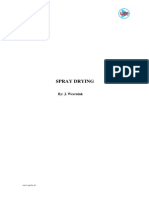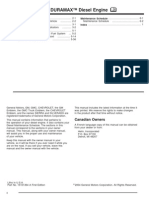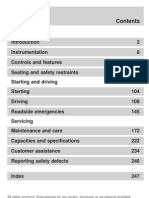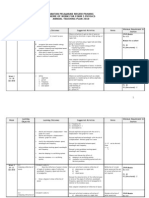0 ratings0% found this document useful (0 votes)
94 viewsTerm Project: Power Requirement For Grinding of Coffee Beans and Screen Analysis
This document is a term project proposal from Bicol University's Department of Chemical Engineering. The proposal aims to determine the power requirement and screen analysis for grinding coffee beans. It introduces grinders as size reduction equipment and discusses Rittinger's Law for estimating the energy required for comminution. Rittinger's Law assumes energy consumed is proportional to the newly generated surface area and provides a formula to calculate the work needed to reduce mass with variables like power, mass flowrate, and mean particle diameters before and after size reduction.
Uploaded by
Wellington FloresCopyright
© © All Rights Reserved
Available Formats
Download as DOCX, PDF, TXT or read online on Scribd
0 ratings0% found this document useful (0 votes)
94 viewsTerm Project: Power Requirement For Grinding of Coffee Beans and Screen Analysis
This document is a term project proposal from Bicol University's Department of Chemical Engineering. The proposal aims to determine the power requirement and screen analysis for grinding coffee beans. It introduces grinders as size reduction equipment and discusses Rittinger's Law for estimating the energy required for comminution. Rittinger's Law assumes energy consumed is proportional to the newly generated surface area and provides a formula to calculate the work needed to reduce mass with variables like power, mass flowrate, and mean particle diameters before and after size reduction.
Uploaded by
Wellington FloresCopyright
© © All Rights Reserved
Available Formats
Download as DOCX, PDF, TXT or read online on Scribd
You are on page 1/ 2
BICOL UNIVERSITY
DEPARTMENT OF CHEMICAL ENGINEERING
Legazpi City, Albay
Term Project: Power Requirement for Grinding of Coffee Beans and
Screen Analysis
Flores, Wellington Jr.,Guillermo, Kenneth, Namora, Zane Arden
Particle Technology
Abstract
The proposal aims to create a product described as a soluble, flowable, dry-to-the-
touch coffee flavored powdered alcohol. It readily and uniformly dissolves in water to form
low-viscosity liquid solution. It is classified as a type of coffee flavored liqueur. It is comprised
of alcohol powder component and coffee mix powder component mixed to form final product.
It is also aimed to determine the specifications and design equipment for the production
process of the product.
Keywords: Rittinger’s Law, Grinder, coffee beans, power requirement, size reduction
____________________________________________________________________________
I. Introduction
A grinder is a type of size reduction
equipment. There are 4 types of size II. Rittinger’s Law
reduction equipment; crushers (coarse The comminution of solid materials
and fine), grinders (intermediate and consumes energy, which is being used to
fine), ultrafine grinders and cutting break up the solid into smaller pieces.
machines. Grinders for intermediate and The comminution energy can be
fine particles are one of the many estimated by Rittinger’s Law, which
processes used for grinding coffee assumes that the energy consumed is
beans. Grinders reduce crushed feed to proportional to the newly generated
powder. Grinding of coffee beans to finer surface area. The formula used to
particle sizes is essential. Contact time, calculate for the energy required is given
Extraction rate and Flow rate are the by the equation:
factors that affect
𝑃 1 1
𝐸= = 𝐾𝑅 [ − ]
𝑚 𝐷𝑝2 𝐷𝑝2
Wherein E is the work needed to reduce a unit mass of feed, P is the gross power in kW, m is the
mass flowrate in kg/m3, KR is the Rittinger’s Constant , DP2 and DP1 are the mean diameter after
and before crushing. The power ratio of two calculated E values from two different size ranges
are calculated using Rittinger’s Law.
You might also like
- 2008 Chevrolet Malibu Service Repair Manual PDF100% (1)2008 Chevrolet Malibu Service Repair Manual PDF19 pages
- (Ebook) - (Drugs) - (Methamphetamine) - (Nazi Labs) - (How To Make Crystal Meth)100% (4)(Ebook) - (Drugs) - (Methamphetamine) - (Nazi Labs) - (How To Make Crystal Meth)7 pages
- BE Civil - Electricity Generation by Solid Waste Management100% (1)BE Civil - Electricity Generation by Solid Waste Management24 pages
- Bsbsus401 Implement and Monitor Environmentally Sustainable Work Practices67% (6)Bsbsus401 Implement and Monitor Environmentally Sustainable Work Practices19 pages
- U2 - Big Assignment For Midterm Presentation: Dept. Food TechnologyNo ratings yetU2 - Big Assignment For Midterm Presentation: Dept. Food Technology63 pages
- Handling Sorting Grading Size ReductionNo ratings yetHandling Sorting Grading Size Reduction70 pages
- Design and Fabrication of Vegetable Shredding Machine CONTENTNo ratings yetDesign and Fabrication of Vegetable Shredding Machine CONTENT46 pages
- Biomass Size Reduction Machines To Enhance Biogas ProductionNo ratings yetBiomass Size Reduction Machines To Enhance Biogas Production18 pages
- KRIIA - 1.2.2 - Publication - Small Scale Coffee DemucilagerNo ratings yetKRIIA - 1.2.2 - Publication - Small Scale Coffee Demucilager7 pages
- Government Engg. College Valsad: Branch:-ChemicalNo ratings yetGovernment Engg. College Valsad: Branch:-Chemical12 pages
- Size Reduction: Richardson and Coulson. Vol. 2No ratings yetSize Reduction: Richardson and Coulson. Vol. 274 pages
- Bartolome 2021 IOP Conf. Ser. Earth Environ. Sci. 633 012002No ratings yetBartolome 2021 IOP Conf. Ser. Earth Environ. Sci. 633 0120029 pages
- Research Agenda and Priorities: RPA 2: Development of Crop Specific Post Harvest EquipmentsNo ratings yetResearch Agenda and Priorities: RPA 2: Development of Crop Specific Post Harvest Equipments4 pages
- Materials The Environment: Ebt 447: Materials Selection and DesignNo ratings yetMaterials The Environment: Ebt 447: Materials Selection and Design37 pages
- Water Resources Planning and Managements Unit - II: (As Per The Syllabus of Pune University)100% (1)Water Resources Planning and Managements Unit - II: (As Per The Syllabus of Pune University)24 pages
- Design and Fabrication of Mini Compost MachineNo ratings yetDesign and Fabrication of Mini Compost Machine3 pages
- Research Paper Organic Waste Shredder For ReferenceNo ratings yetResearch Paper Organic Waste Shredder For Reference6 pages
- Energy Audit and Management: Prof. C. S. Solanki Department of Energy Science and EngineeringNo ratings yetEnergy Audit and Management: Prof. C. S. Solanki Department of Energy Science and Engineering43 pages
- Instituto Tecnológico Superior Progreso Ingeniería en Energías RenovablesNo ratings yetInstituto Tecnológico Superior Progreso Ingeniería en Energías Renovables11 pages
- Ita Cookstove Jalinga Ethos Version by Psa 2018 01 26 180126140333 PDFNo ratings yetIta Cookstove Jalinga Ethos Version by Psa 2018 01 26 180126140333 PDF25 pages
- Turning Up The Heat by Turning Down The Heat: in Hospitality On EnvironmentNo ratings yetTurning Up The Heat by Turning Down The Heat: in Hospitality On Environment33 pages
- SISSTA SEMINAR 2024 - Technical Papers Only100% (2)SISSTA SEMINAR 2024 - Technical Papers Only95 pages
- Design of Portable Coffee Roaster For Home Industr PDF100% (1)Design of Portable Coffee Roaster For Home Industr PDF6 pages
- Life Cycle Analysis: "Cradle To Grave" Designed For Sustainability W.R.T. A Major Indian Petro Chemical IndustryNo ratings yetLife Cycle Analysis: "Cradle To Grave" Designed For Sustainability W.R.T. A Major Indian Petro Chemical Industry42 pages
- Green Computing How to Build a Sustainable Tech LifestyleFrom EverandGreen Computing How to Build a Sustainable Tech LifestyleNo ratings yet
- PLDT Home Fiber and PLDT Home DSL New Default Wifi Password Hack100% (1)PLDT Home Fiber and PLDT Home DSL New Default Wifi Password Hack1 page
- Kverneland KV DUO 1814 2218 3022 Apevaunut ENGNo ratings yetKverneland KV DUO 1814 2218 3022 Apevaunut ENG24 pages
- Apparatus & Equipment Chemical Reagents: Department of Chemical EngineeringNo ratings yetApparatus & Equipment Chemical Reagents: Department of Chemical Engineering6 pages
- Methods of Research: Critical Review in Adsorption of Copper by Raw PineconeNo ratings yetMethods of Research: Critical Review in Adsorption of Copper by Raw Pinecone2 pages
- 2005DuramaxManual Like s10 Diesel Engines PDFNo ratings yet2005DuramaxManual Like s10 Diesel Engines PDF78 pages
- DiagnosticsProcedureOnPowerStroke6.0L 11.2010100% (1)DiagnosticsProcedureOnPowerStroke6.0L 11.20107 pages
- 2000 Super Duty F-250, F-350, F-450, F-550 Owner Guide100% (7)2000 Super Duty F-250, F-350, F-450, F-550 Owner Guide256 pages
- "6.0L Power Stroke Diagnostics": Technical Article67% (3)"6.0L Power Stroke Diagnostics": Technical Article4 pages
- Croda Eseminar Coatings Polymers Mar 312010100% (1)Croda Eseminar Coatings Polymers Mar 31201032 pages
- Sample - Physics Form 5yearly Lesson Plan 2010No ratings yetSample - Physics Form 5yearly Lesson Plan 201020 pages
- Gravity Separation-Old Technique-New Methods PDFNo ratings yetGravity Separation-Old Technique-New Methods PDF19 pages
- Cs 414 Indian Institute of Technology, BombayNo ratings yetCs 414 Indian Institute of Technology, Bombay17 pages























































































































